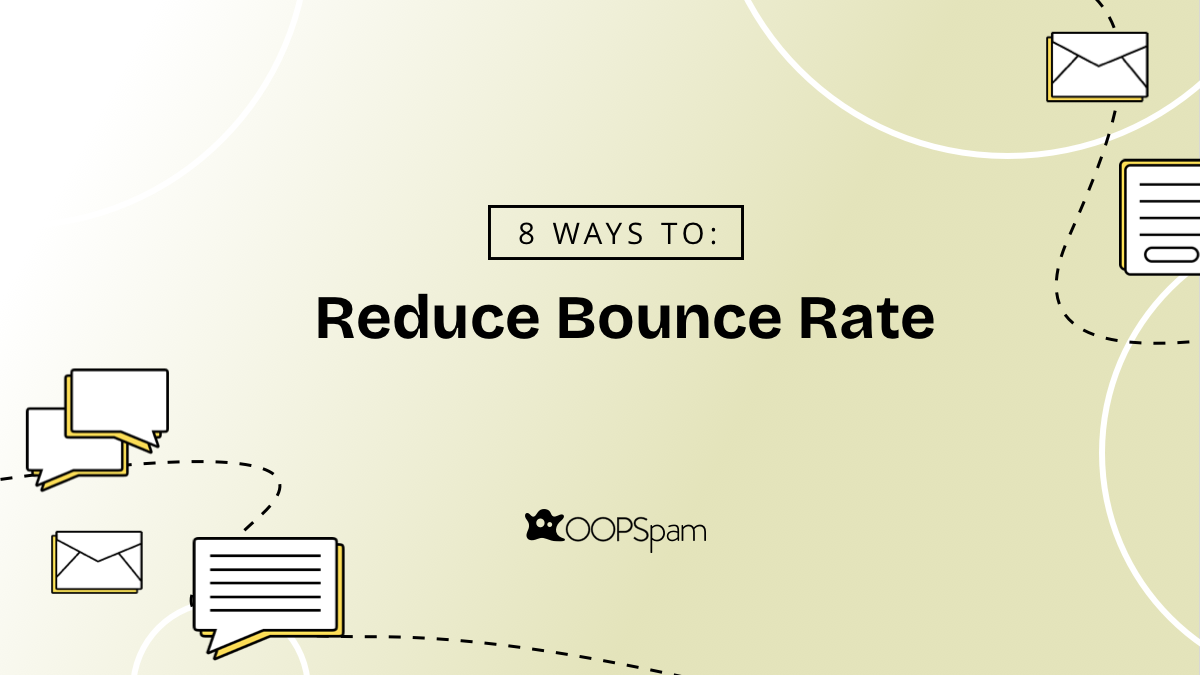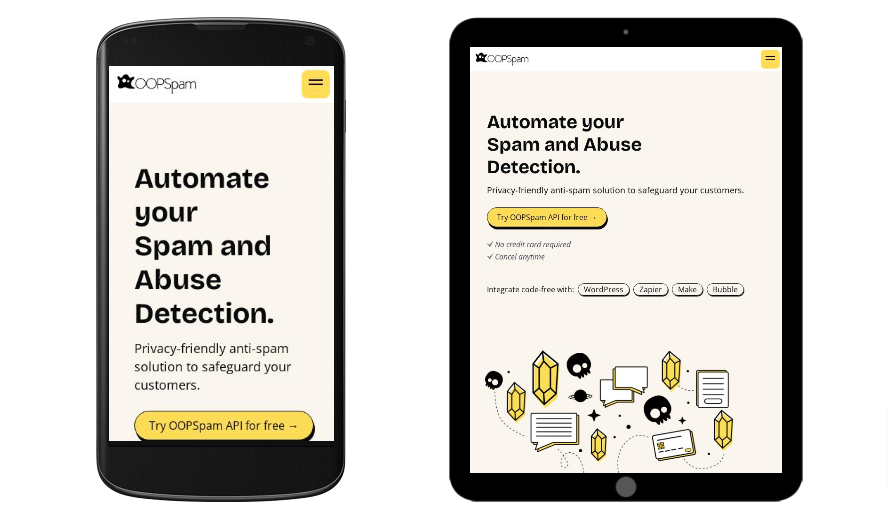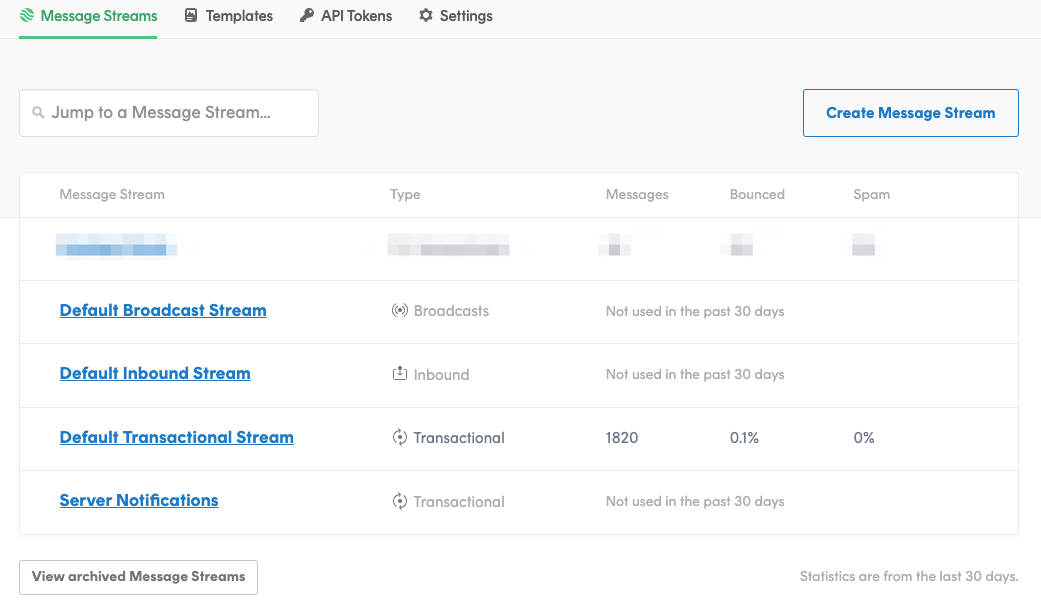
Chazie Baniquid
Technical Content Marketer
13 minutes to read
8 Ways to Reduce Bounce Rate

Is your bounce rate a little higher than you’d like? You’re driving traffic to your website, but visitors just aren’t sticking around. 🤔
They’re landing on a page, taking a quick look, and then poof — they’re gone. That’s bounce rate for you.
In this guide, I’ll walk you through exactly what bounce rate is and, more importantly, how to reduce it with actionable, no-nonsense strategies. By the end, you’ll be armed with a toolkit to keep visitors engaged and exploring.
And as a bonus, I’ll show you how OOPSpam can help create a cleaner, more engaging environment on your site.
What is Bounce Rate?
First things first — what exactly is bounce rate?
Simply put, it’s the percentage of visitors who land on a single page on your site and leave without exploring further. They don’t click any links, they don’t visit other pages, they just take a quick look and bounce.
Why a High Bounce Rate Can Be a Problem
If you’re trying to get visitors to convert, a high bounce rate is like putting up a “Do Not Enter” sign.
It means users aren’t finding what they need, or worse, your site isn’t engaging enough to keep them there. Lowering your bounce rate can lead to higher engagement, better conversions, and, yes, even a boost in your search rankings.
So, let’s get to the fun part — how to bring that bounce rate down.
8 Effective Ways to Reduce Bounce Rate
Here are eight proven strategies to help you out.
1. Optimize Content for User Intent
Imagine you’re looking for tips on how to care for indoor plants, and you end up on a page selling plant pots.
Close, but not quite what you needed, right? This is why aligning your content with user intent is crucial.
What is User Intent?
User intent is the “why” behind a search query. Are users looking for information, a specific product, or maybe a how-to guide?
To optimize for intent, research your audience’s goals and create content that matches.
How to Optimize Content for Intent

- Analyze Search Queries: Use tools like Google Search Console or Google Analytics to see which keywords bring users to your site.
- Structure Content to Answer Questions: If users are searching for answers, make sure your content provides them upfront and then offers additional resources to explore further.
- Be Clear in Your Headlines: Your page headline and meta description should clearly reflect what the user will find on the page.
Aligning content with user intent keeps visitors around because they feel understood and valued.
2. Improve Page Load Speed
Ever been on a website that took ages to load? Chances are, you didn’t stick around. Page speed can make or break your bounce rate.
Tips to Boost Site Speed
- Optimize Images: Large, high-resolution images can be a drag (literally). Compress images without sacrificing quality.
- Enable Caching: Use browser caching to store frequently accessed files so that returning visitors don’t have to load the entire site every time.
- Use a Content Delivery Network (CDN): CDNs distribute content globally, reducing load times for users no matter where they are.
- Minimize JavaScript and CSS Files: Excessive code can slow down your site. Use tools like PageSpeed Insights to identify areas for improvement.
How OOPSpam Can Help
Spam can slow down your website by clogging up the backend and interfering with performance. For WordPress users, OOPSpam also offers the OOPSpam WordPress plugin, making it easy to implement powerful spam-blocking features directly on your WordPress site.
This plugin integrates seamlessly to help WordPress websites maintain a spam-free, high-performance environment, keeping your visitors engaged and enhancing overall user experience.
🌟 Remember: faster sites are happier sites, and visitors are much more likely to stick around if they don’t have to wait forever for the page to load.
3. Create a Mobile-Friendly Experience

With over half of web traffic now coming from mobile devices, ensuring your site is mobile-friendly is non-negotiable. People browsing on their phones won’t stick around if they have to pinch, zoom, and squint to read your content.
Steps to Optimize for Mobile
- Responsive Design: Ensure your site adapts to different screen sizes.
- Mobile-Only Features: Use mobile-specific options like click-to-call buttons for easy navigation.
- Readable Text: Keep font sizes large enough for easy reading on smaller screens.
- Minimize Pop-Ups: Mobile users especially hate pop-ups, so use them sparingly. If you absolutely need them, ensure they’re easy to close.
Optimizing for mobile ensures you’re not missing out on that vast mobile audience.
4. Provide Clear and Relevant Calls-to-Action (CTAs)
Every page on your website should have a purpose, and a clear CTA guides visitors toward that goal—whether that’s signing up for a newsletter, purchasing a product, or simply reading more content.
If your CTAs are unclear, irrelevant, or buried on the page, visitors are likely to leave without engaging further.
Tips for Effective CTAs
- Match CTA to User Intent: Use relevant CTAs that guide users toward the next step.
- Place CTAs Strategically: Position them where they’re easy to find, like above the fold or at the end of valuable content.
- Keep CTAs Concise: A strong CTA should be clear, direct, and action-oriented.
🎯 If you’re ever unsure, try A/B testing different CTAs to see what works best. Testing can often reveal surprising insights!
5. Use Internal Links to Encourage Exploration
One of the best ways to keep visitors on your website is by encouraging them to explore more pages.
Internal linking helps visitors navigate your site, discover additional resources, and find more of the content they’re interested in. It also helps spread link equity across your site, which is beneficial for SEO.
How to Use Internal Links Strategically
- ‘Related Posts’ Section: Include links to related posts at the end of each article.
- In-Text Links: Link to other helpful pages naturally within your content.
- Add a Table of Contents: For longer pages or blog posts, a table of contents allows users to quickly jump to the sections that interest them.
- Navigation Breadcrumbs: A breadcrumb trail helps visitors see how to navigate further.
Internal links create a roadmap through your site, keeping visitors engaged and exploring.
6. Maintain a Spam-Free, Professional Environment with OOPSpam

No one wants to deal with a website cluttered with spammy comments, fake sign-ups, or annoying popups.
A spam-free environment not only looks more professional but also helps keep your visitors engaged and focused, significantly reducing bounce rates. That’s where OOPSpam (yep, that’s us! 👋) steps in to make a difference.
OOPSpam is a powerful tool designed to keep your website clean and free from spam. By blocking unwanted messages, preventing malicious activity, and ensuring your website remains user-friendly, OOPSpam can help keep visitors engaged by providing a seamless, distraction-free experience.
How OOPSpam Helps
OOPSpam offers a range of advanced tools that ensure your website stays spam-free and user-friendly. Here’s how:
- Advanced Spam Filtering: OOPSpam filters out spam across comments, forms, and other text-based interactions, keeping your website clean and interactions authentic.
- Block Malicious IPs: By identifying and blocking IPs associated with spam or malicious activities, OOPSpam helps prevent harmful users from even reaching your site. This proactive approach not only secures your site but also keeps it optimized and safe for genuine visitors.
- Block Malicious and Disposable Emails: OOPSpam blocks both malicious emails and disposable/temporary email addresses, reducing the risk of high bounce rates due to invalid or non-existent email addresses. As a result, your email lists remain healthy, and the likelihood of hard bounces is minimized.
- Privacy-Centric: Unlike many spam filters, OOPSpam operates without tracking users, meaning you maintain a safe, privacy-compliant experience for your visitors. This focus on privacy builds trust with your audience, encouraging them to engage more with your content.
- Enhanced Site Performance: Filtering out bots, junk data, and other spam elements keeps your website fast and efficient. This optimized performance is essential for keeping users engaged, as visitors are more likely to bounce if a site is slow or cluttered.
Real-World Example: How OOPSpam Helps Keep Bounce Rate Low

To illustrate OOPSpam’s impact, check out the image above.
🛡️ Over the past 30 days, our Default Transactional Stream processed 1,820 emails with an impressively low 0.1% bounce rate and 0% spam rate.
With OOPSpam’s tools, your website can maintain a professional, trustworthy environment that keeps visitors engaged, minimizes bounce rate, and improves the overall user experience.
7. Optimize Your Site for Faster Conversion
Sometimes, users leave because they can’t find what they’re looking for quickly. That’s why you need to ensure your conversion paths are smooth and fast.
How to Implement This:
- Clear Navigation: Make sure visitors can easily find key sections of your site, such as product pages or service offerings.
- Keep Paragraphs Short: Shorter paragraphs are easier to scan, especially on mobile.
- Shorten Forms: Reduce the number of fields in forms to make the process faster and less intimidating.
- Simplify Checkout: If you run an eCommerce site, ensure the checkout process is quick and hassle-free.
By streamlining conversion processes, you make it easier for visitors to stay engaged and complete the actions you want.
8. Show Targeted Content to Returning or Engaged Users
Not every bounce is a bad thing.
If a user finds what they’re looking for on your page, reads it, and leaves satisfied, that’s a win.
But what if they want more? Showing targeted content based on user behavior encourages further exploration.
Ways to Show Targeted Content
- Related Content Based on Interests: Use tools like Google Analytics to identify popular content and suggest similar articles.
- Behavior-Based Popups: Consider gentle popups that suggest relevant content to users who have shown high engagement.
- Use Retargeting Ads: Retargeting ads can help bring visitors back to your site by showing them content they’ve already interacted with.
When done well, targeted content can transform one-time visitors into repeat visitors, helping reduce bounce rate.
How to Track Bounce Rate on Google Analytics 4 (GA4)
Curious about how these changes impact your bounce rate? GA4 has a new approach to bounce rate, focusing on engagement.

Steps to Find Bounce Rate in GA4
- Go to the Reports tab on the left side panel of GA4.
- Navigate to Engagement > Pages and screens.
- Click the pencil icon in the upper right to customize.
- Add Bounce rate to your metrics.
- Click Apply and save changes.
Tracking bounce rate over time helps you see which changes are working and what areas may still need improvement.
Wrapping It Up
Reducing bounce rate isn’t about tricking visitors into staying on your site longer. It’s about creating an experience that genuinely meets their needs and encourages them to engage further. By optimizing for user intent, improving load times, making your site mobile-friendly, and using tools like OOPSpam to maintain a spam-free environment, you can keep visitors engaged and make a lasting impression.
Start implementing these strategies today and watch your bounce rate decrease, your engagement increase, and your conversions goes up.
Happy optimizing! 🌟